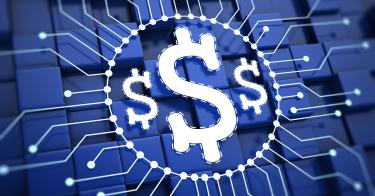Imagine if a bureaucrat had the power to limit your savings or place a "shelf-life" on money you earn. Sound farfetched? Ideas like this are already being floated in the United Kingdom as the Bank of England—the model for the Federal Reserve—barrels headlong towards a digital currency. Americans should be concerned because the Fed looks to be following in its parent’s footsteps.
The digital dollar being advocated by members of the Treasury and Federal Reserve is an example of a central bank digital currency (CBDC). At first blush, our currency already appears to be digitized. Many people no longer carry physical cash and instead use digital payment methods like a chipped credit card or their smartphones. Likewise, direct deposit has become the standard method of payment for labor. Dollars are transferred in a stream of ones and zeros, not paper bills and metal coins.
But those dollars are inherently fungible. It’s irrelevant if you accept or pay with any particular dollar, because each one functions exactly the same way as any other. CBDCs are different. They are programmable, traceable, trackable and taxable.
CBDCs are entirely under bureaucratic control because every digital dollar has a unique fingerprint. Literally all transactions can be surveilled, recorded, or even reversed by a bureaucrat’s push of a button. Not only can the government tell how much you’re spending or saving, but what you’re spending those dollars on and where you’re parking your savings.
>>> Central Bank Digital Currencies: A Solution in Search of a Problem
CBDC’s can be earmarked for certain purchases and forbidden from others. The government can easily dictate which dollars of your income go to buying food (and what kind of food), for instance. That’s particularly alarming in an era when the elites lecture about climate change and push for people to eat less beef and more bugs.
Imagine the government creating dollars that can only be used for food, thereby dictating to you how much of your income can be spent that way. That is basically what happens with food stamps, which can only be used at certain establishments and only on certain items.
Likewise, imagine the government dictating which dollars you can use to heat or cool your home. Sound implausible? There are already multiple instances of governments taking control of families’ digital thermostats—without their knowledge, let alone their permission—to dictate what temperature their homes would be.
With a CBDC, the central bank can also effectively force spending and prevent saving by imposing maximum savings levels and preventing "hoarding" by confiscating unspent digital dollars; people with no savings are more reliant on government in "emergencies." If you’re unable to save for a rainy day, you’re at the whim of a bureaucrat holding the purse strings of your life.
That same level of surveillance extends to every transaction, no matter how small, like paying a babysitter or borrowing money from a friend. And a traced transaction can also be taxed.
Lest you think the government would not bother with such transfers, consider that the IRS is seeking to implement a reporting program to tax the tips of bartenders and waitresses. This follows a warning to report any transfers via apps of $600 or more—so much for going after billionaires.
CBDCs also allow for an unparalleled level of collusion between big business and big government. Businesses can be given preferred status, where certain digital dollars may only be spent with those establishments.
>>> The Fed Should Not Create a Digital U.S. Dollar
Conversely, some dollars may not work at certain businesses, like a gas station, if government wants to discourage a product or service. Goals which bureaucrats try to achieve through manipulation of the tax code, like subsidizing solar panels and taxing oil, could easily be forced on the public with a CBDC.
Equally worrisome would be the Fed’s ability to inflate and devalue the currency. CBDCs make this process effortless by removing private banks from the Fed’s methods of creating money—guaranteeing future inflation and runaway government spending. In fact, the Fed would not even need private banks with a CBDC; all borrowing by consumers could happen directly through the central bank.
This is another scary proposition, since bureaucrats could turn down people for loans based upon things other than their likelihood of repaying. Are you not woke enough? Then no mortgage for you. A CBDC makes such dystopian scenarios possible, and perhaps inevitable.
What does a CBDC represent? In a word, control. Perhaps that is why Treasury Secretary Janet Yellen and President Joe Biden are so supportive of the idea. A digital dollar would give them and future administrations a level of power so unprecedented that Orwell could not have envisioned it. After the economic damage that federal intervention has caused, the last thing the government deserves is more power.
This piece originally appeared in Fox News




